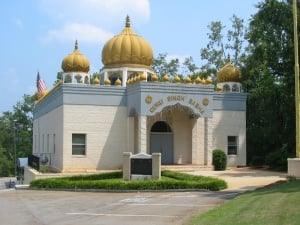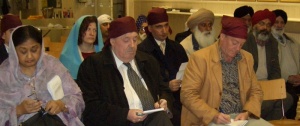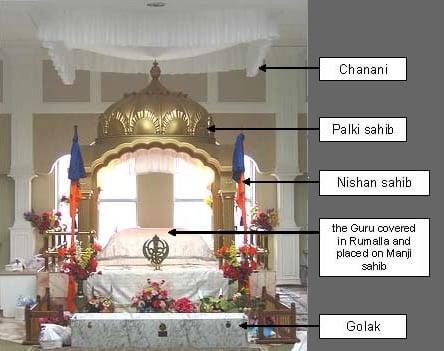Gurdwara
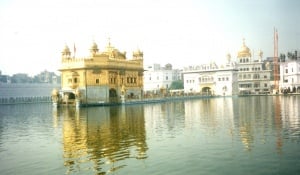
Gurdwara: (Gurmukhi: ਗੁਰਦੁਆਰਾ) literally Guru's portal/ abode / House or Door. In the early period of Sikhism, before the advent of the word "Gurdwara", the word "Dharamsala" was used to refer to Sikh places of worship and service (Sewa). The word can be split into two: "Gur" or "Guru" referring to their Guru, Guru Granth Sahib i.e. Gurbani / Waheguru / the word Shabad and "duwara" meaning "Door" of the "House."
Although most Sikhs spell "Gurdwara" and refer it as the House of the Guru, that may not be the accurate spelling and meaning. If we look at the word "Gurdwara" closely in Gurmukhi, and compare it to each time it has been mentioned in the Sri Guru Granth Sahib or Bhai Gurdas ji's Vaars, there is no "vava" or "w" sound in it. The word is actually spelt "Gur-duara." The word Dwara means place or home, but Duara means through or by means of. So the accurate defination of a "Gurduara" would be through or by means of our Guru. For a Sikh, every thing is achieved by means/by grace of the Guru.
Sikhism has no room for symbolism or ritualism; Sikhs have neither idols nor altars in their Gurdwara. They have no sacraments and no priestly order. The essential feature of a gurdwara is the presiding presence in it of the holy Sikh Scripture, called the Guru Granth Sahib also referred to as Satguru. This essentially is the focal point of a Gurdwara. The other main component is the holy congregation called the Sadh Sangat who are present within this sacred structure in humble obedience of principles laid down by the Sikh Gurus.
The Sikhs hold high respect for the commandments laid down in the Guru Granth Sahib and most faithful adherents will adhere to these commandments at all costs. Within the Gurdwara the Sikhs engage in prayer (Simran or Naam Japna) and in voluntary service called Sewa. Langar, free community kitchen serves meals to anyone who visits this Sikh institution. All the facilities are generally managed on a voluntary basis by volunteers called Sewadars (lit. those who serve). Generally very few paid staff are maintained in Gurdwaras.
This is the place where the young Sikhs learn the essentials of their faith and as they grow older this becomes their spiritual training centre - the KHALSA training institution; a place for organised "Satgur de Seva" or service of the True Guru.
Darbar Sahib in Amritsar, Punjab, India is the focal institution for all the Gurdwaras located the world over.
Background
In early Sikhism, the place used for Congregational prayers was called a dharamsala, the abode of dharma, different from the modern usage which generally limits the term to a resting place. According to the Janam Sakhis, Guru Nanak wherever he went, called upon his followers to establish dharamsalas and congregate in them to repeat God's Name, and to recite His praise. He himself established one at Kartarpur on the bank of the River Ravi, where he settled down at the end of his extensive preaching tours. "I have set up a dharamsal of truth," sang Guru Arjan (1563-1606). "I seek the Sikhs of the Guru (to congregate therein) so that I may serve them and bow at their feet" (GG, 73).
In the time of Guru Hargobind (1595-1644), dharamsals had began to be called gurdwaras. The change of nomenclature was significant. Guru Arjan had compiled in 1604 a Book, pothi or granth (later Guru Granth Sahib) of holy hymns. Besides his own, he had included in the granth the compositions of not only his four spiritual predecessors, but had also included some compositions by Indian saints and sufis. "The pothi is the abode of the Divine," said he (GG, 1226). This first copy of the Granth he installed in the central Sikh shrine, the Harmandar, at Amritsar. Copies of the Granth began to be piously transcribed. The devotees carried them on their heads for installation in their respective dharamsals. Reverently, the Book was called the Guru Granth Sahib and was treated as a sacred embodiment of the Gurus' revealed utterances. The dharamsal where the Guru Granth Sahib was kept came to be called a gurdwara. The designation became universal after the guruship was passed to the holy Book, although the central shrine at Amritsar continued to be called Harmandar or Darbar Sahib.
Ending the line of living Gurus, Guru Gobind Singh, the 10th Nanak, had installed the sacred volume in 1708 as his eternal successor. The Holy Book has since been the Guru for the Sikhs and it must reign over all Sikh places of worship where religious ceremony focuses around it. The basic condition for a Sikh place to be so known is the installation in it of the Guru Granth Sahib. Every Sikh place by that token is the house of the Guru. Hence the name Gurdwara (gur+dwara= the guru's door).
During the second half of the eighteenth century and after, as the Sikhs acquired territory, gurdwaras sprang up in most of the Sikh habitations and on sites connected with the lives of the Gurus and with events in Sikh history. Most of the historical gurdwaras were endowed by the ruling chiefs and nobility with liberal grants of land called Jagirs to support them.
However, in many cases this well intentioned philanthropy, led to the rise of a hereditary priesthood, that had begun to think of the Gurdwara and its supporting lands as their own personal fiefs. Some had even introduced practices and condoning behavior that shocked the Sangats of the Gurdwaras. Such behavior was brought to an end through a series of non-violent, sustained agitation, which culminated in securing from the Punjab Legislative Council, legislation called the Sikh Gurdwaras Act of 1925, that provided for the management of the major historical Sikh shrines by a body known as the Shiromani Gurdwara Parbandhak Committee; a body elected through adult franchise under government auspices. This kind of democratic control is a unique ecclesiastical feature. Most of the shrines not covered by the Gurdwaras Act are administered by committees chosen by local sangats. Though on the part of the Sikhs the Morchas were non-violent, many of the Mahants, as the custodians were called, thought nothing of murdering thousands of Sikhs (often with Government support).
Best Men / Women of saintly standing, well versed with the fundamentals of Gurmat and Gurbani in the Sikh community are selected by the KHALSA (Panj Piara) (best 5 Sikh intellectuals who are publicly acknowledged as true Sikhs) to constitute Gurdwara Management committee.
Anyone of the five selected Sikhs, best males or females, normally (but not necessarily) the senior most in age, may become president to represent this organisation of Panj Piaras institutionalised by the 10th Nanak, Guru Gobind Singh. These selected five best Sikhs are by default expected to be epitomes of Daya (concern for the Sikh 'Have Nots'), Dharm ( Truthfulness), Himmat (Courage and Conviction), Mohkam (Demonstrative Ability to Lead Truthfully) Sahib ( The Head of the organisation possessing all these four holy attributes (Daya, Dharam, Himmat, Leadership).
As Sikhism has no priesthood, administrative control of gurdwaras is exercised by the best Sikhs selected (not elected) by the sangat strictly as per the local requirements. The Shiromani Gurdwara Parbandhak Committee provides all available resources to the community for understanding the Commandments of 'Satguru' as formally documented in the Guru Granth Sahib.
People of any racial, social, political or religious or non-religious belief are welcomed guests at any Gurdwara. However, the Sikh rahit maryada or code of conduct contains rules pertaining to those entering a Gurdwara. For example:
- No one should enter the gurdwara premises without first removing their shoes (racks are usually provided for this purpose).
- Men and women must both cover their heads (Headscarves are usually provided).
- All tobacco products or non-prescription medication (i.e. drugs) should never be taken into a Gurdwara.
Other rules in the rahit maryada concern the conduct of religious service and reverence due to SatGur. Rules also prohibit discrimination in the sangat on the basis of religion, caste, sex or social position, and the observation of idolatrous and superstitious practices.
Features of a Gurdwara
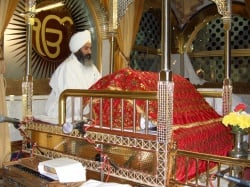
A Gurdwara is identified by the following five basic features:-
- 1.The Guru i.e. the Sikh holy book. A hall called Darbar Sahib, houses the Guru. This hall in most modern temples is large and will house many hundreds of visitors.
- 2.Nishan, short for Nishan Sahib is a triangular orange flag with a Khalsa emblem of a (Khanda)in the middle. It expresses the faith of Sikh Community in the True Lord or Satguru & Guru Granth Sahib. It is a Khalsa icon for the TRUE Guru's abode
- 3. Pangat i.e. Free community kitchen. It is part of a building complex where communal meals are served. It may have tables and chairs, but as a tradition it is expected from the devotees to sit on the floor.
- 4. Sangat is a holy congregation of the 'saint soldiers', which in the purest form is called the Khalsa. As per Sikh faith, this Khalsa congregation also represents the combined spirit of the ONE(True eternal God) personified and with the Bani of the Shabad Guru] as present in Sach Khand. Gurbani singers & those regulating the function will normally address the holy congregation (sangat)as "Guru Roop Sadh Sangat" literally meaning " Congregation endowed with the power of the Guru" (i.e. "gathering of the "Pure" or Khalsa")
- 5. Golak refers to a systematic & formal financial system in the custody of Guru Granth Sahib. The Gurdwara management team, on behalf of Guru Granth Sahib manages the account, expenditures, donations, gifts, etc.
In addition to the 5 Basic features, a Gurdwara may have:
- 6. Rest Room for the SGGS: A room where the Sikh Holy Book is placed overnight. This room is sometimes called "Sach Khand" (which translates to abode of 'True God' /Pure Domain /Paradise )
- 7. Various utility rooms, wash-rooms, kitchen, etc. Some of the larger Sikh temples may also have rooms for the devotees to stay overnight with bathroom facilities.
The Guru's throne
The Guru's throne is always centered at the front of the Darbar Hall, it is the central feature of the Gurdwara. As you walk into the main prayer hall in a Sikh temple, you will observe this immediately. The essential features of the Guru's throne are the:
- Chanani
- Manji sahib
- Palki sahib
- Rumalla and small pillows
- Chaur sahib
- Golak
- Nishan sahib
The Guru
Sikhs treat their holy book as a living Teacher/Guru. This act of respect is a public resolution of a Sikh's commitment to the holy script or message or Shabad within the Guru. The Guru promotes a life of truthful living dedicated to nothing but the One True Lord and His Creation. The Sikh by walking on the path encapsulated in Guru Granth Sahib honours the tradition set by the ten Sikh Gurus.
Essence of the term 'worship' in Sikhism is to dedicate ones life to the path set in the Guru Granth Sahib. This way of life is different from that normally followed by and understood by ordinary people. 'Worship' here is living with the 'True Lord' in one's own mind and 'serving the GURU' ie 'faithfully following the instruction outlined in the Guru Granth Sahib by:
- Listening
- Singing/Reciting
- Understanding
- Believing
- Serving
Also, a Sikh's shrine of worship is also 'his or her own mind'. This worship is a continuous process which only ends after the soul leaves the body when the person dies and becomes part of 'Eternal Spirit'.
The Sikhs worship nothing but the 'One True God' who does not reside in any specific temples or holy places. For a Sikh nothing else is holy apart from following the path set out in the Guru Granth - the path of 'truthful living'. As the "True Lord" prevails in all the universes beyond the known universe; for a Sikh all ritualistic and traditional worship, being too trivial to please this Almighty God; rituals are not part of the Sikh way.
Chanani
Chanani is a canopy normally made of highly decorated cloth which covers the scriptures as is used as a mark of respect. The platform where the Guru Granth sahib is placed in the darbar sahib is covered on top with a rectangular canopy called a Chanani, which is a large covering made of rich cloth attached high above the Guru's seating near the ceiling secured to the roof of the hall or held high by 4 posts.
Manji
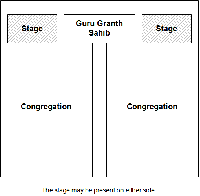
Manji is a Punjabi word for a small bed and sahib is term to show respect for the item described in the preceding word. The term Manji sahib is used in the Sikh tradition for the small bed on which the Holy Sikh Scriptures, Sri Guru Granth Sahib is placed during the day in the main hall (Darbar Sahib) of the Gurdwara.
Rumalla
Rumalla is a Punjabi term for a square or rectangular piece of silk or other cloth material used to cover the Guru Granth Sahib in the Gurdwara (Sikh temple) when it is not being read. Rumallas are sometimes brought as gifts when people attend the services at the Sikh Gurdwara.
Palki
Palki is where the Guru resides, when the Guru is carried from one place to another. Sikhs regard the holy scriptures as their living Guru. The Guru Granth Sahib is placed on the Manji Sahib - a raised platform covered by the Palki - a canopy, to show its importance. The Guru Granth Sahib is covered by a piece of beautiful material called a Rumalla and flowers are placed round it. Around the top of the canopy may be engraved the word 'Waheguru' which means 'Wonderful Lord'.
Nishan
Its external distinguishing mark is the Nishan Sahib or the Sikh flag, saffron in colour, that flies day and night atop the building, or, more often, separately close to it.
Golak
A systematic & formal Financial Management System, in the custudy of Satgur Granth Sahib exists in every Gurdwara. The Gurdwara management team, on behalf of Satgur Granth Sahib manages the account, expentitures, donations & gifts etc. .....
Other features
Pangat
- Main article: Pangat
The aspect of Sikhism most closely associated with the gurdwara, other than worship, is the institution of Guru ka Langar or free community kitchen which encourages commensality. Seva or voluntary service in Guru ka Langar is considered by Sikhs a pious duty. The Langar or free kitchen was started by the first Sikh Guru, Guru Nanak Dev. It is designed to uphold the principle of equality between all people of the world regardless of religion, caste, colour, creed, age, gender or social status. In addition to the ideals of equality, the tradition of Langar expresses the ethics of sharing, community, inclusiveness and oneness of all humankind. "..the Light of God is in all hearts." (sggs 282)
Sangat
- Main article: Sangat
A second characteristic of a [gurdwara]] is its being universal public place open to all devotees to pray individually or to assemble in congregation. Traditionally the devotees will sit cross legged on floor, however a convenient sitting arrangements for sick & elderly, normally along the walls, as required, may be made by the Gurdwara Management Team.
All those who enter Darbar Sahib, as asocial protocol & expression of love & faith in Satgur Granth Sahib, remove their shoes and cover their heads before entering. The devotees normally on entering this hall will walk slowly and respectfully to the dominant throne graced by Satgur Granth Sahib. They then stand before the Holy Scriptures, may say silent prayers, may offer any gifts to the Guru and then bow humbly before the Granth Sahib.
Gurdwara Architecture
Unlike the places of worship in some other religious systems, gurdwara buildings do not have to conform to any set architectural design. The only established requirement is the installation of the Guru Granth Sahib, under a canopy or in a canopied seat, usually on a platform higher than the floor on which the devotees sit, and a tall Sikh pennant atop the building.
Lately, more and more gurdwaras have been having buildings imitating more or less the Harimander pattern, a mixture of Indo-Persian architecture. Most of them have square halls, stand on a higher plinth, have entrances on all four sides, and have square or octagonal domed sanctums usually in the middle. During recent decades, to meet the requirements of larger gatherings, bigger and better ventilated assembly halls with the sanctum at one end have become accepted style. The location of the sanctum, more often than not, is such as to allow space for circumambulation. Sometimes, to augment the space, verandahs are built to skirt the hall. Popular model for the dome is the ribbed lotus topped by an ornamental pinnacle. Arched copings, kiosks and solid domelets are used for exterior decorations.
For functions other than purely religious, a gurdwara complex must provide, in the same or adjacent compound, for Guru ka Langar and accommodation for pilgrims.
The main function of the gurdwara is to provide Sikhs with a meeting-place for GurSeva. This mainly consists of listening to the words of the Guru Granth Sahib, singing them to musical accompaniment and hearing them expounded in katha, or lectures: and sermons.
The gurdwara also serves as a community centre, a school, a guest house for pilgrims and travellers, occasionally a clinic, and a base for local charitable activities. Apart from morning and evening services, the gurdwaras hold special congregations to mark important anniversaries on the Sikh calendar. They become scenes of much éclat and festivity when celebrations in honour of the birth anniversaries of the Gurus and of the Khalsa take place.
Galleries
Photos by Harpreet Singh
- Trip To Amritsar(2008)
- Trip To Harian Vailan(2008)
- Trip To Chamkaur Sahib(2008)
- Trip To South India
- Local Trip Mohali District & Chandigarh, Panchkula District(2008)
- Trip To Gurdwara Bhai Joga Singh(2008)
- Guru Maneyo Granth Jagriti Yatra(2008)
- Trip To Fatehgarh Sahib(2008)
- Darshan Gurdwara Puddha Sahib(2008)
- Trip to Patna Sahib(2002)
- Trip to Gurdwara Jahara Jahoor
- Trip to Gurdwaras of Hoshiarpur district(12:5:2008)
- Trip to Harimandir Sahib & Baba Bakala(19:05:2008)
- Other Useful Additions
- My Creations
- Trip on Martydom Day Guru Arjun 2008
- Gurdwara Janam Asthaan Mata Sunder Kaur
Photos by Parminder Singh
See Also
- Visiting a Gurdwara
- Attending a Sikh Wedding
- SGGS
- SGGS Protocol
- Gurdwaras
- Gurdwara in detail
- Gurdwara gallery
Bibliography
- 1. Patwant Singh, Gurdwaras in India and around the World. Delhi, 1992
- 2. Arshi, P.S., The Sikh Architecture. Delhi, 1984
- 3. Madanjit Kaur, The Golden Temple: Past and Present. Amritsar, 1983
- 4. Teja Singh, Sikhism: Its Ideals and Institutions. Bombay, 1938
- 5. Cole, W. Owen and Piara Singh Sambhi, The Sikhs: Their Religious Beliefs and Practices. Delhi, 1978
- 6. Prakash Singh, The Sikh Gurus and the Temple of Bread. Amritsar, 1964
- 7. Pratap Singh, Giani, Gurudwara Sudhar arthat Akali Lahir. Amritsar, 1975
Above adapted from article By Fauja Singh
